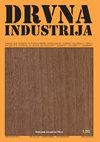The Influence of Heating Degree Days on Fuelwood Consumption in Households in Selected Countries of Central and Southeastern Europe
IF 0.8
4区 农林科学
Q4 MATERIALS SCIENCE, PAPER & WOOD
引用次数: 0
Abstract
Serbia is one of the few European countries that does not keep official statistics and does not have data on heating degree days. A heating degree day (HDD) represents a measure to quantify the energy needs for heating a building. In order to create a database, six meteorological stations in Serbia had been selected, for which the heating degree days were calculated for every year in the period 2010-2018. The months with the highest values of heating degree days were also determined for each year of the analyzed period. In addition to the annual level, heating degree days in the heating seasons over the analyzed period were calculated for the six selected stations, as well as the length and the average air temperature of each heating season. In Serbia, heating season officially lasts from October 15 to April 15. To determine the influence of the calculated annual heating degree days on fuelwood consumption in households in Serbia, over the period 2010-2018, multiple econometric models were formulated. The influence of the annual values of heating degree days on fuelwood consumption for household space heating in Slovenia and Croatia was analyzed, as well. The analysis of energy consumption in the households of the selected countries showed that wood fuels are mostly used for heating, primarily fuelwood. This is the reason why this type of fuel was selected for the research.供热度日对欧洲中部和东南部选定国家家庭薪材消费的影响
塞尔维亚是少数几个没有官方统计数据的欧洲国家之一,也没有供暖天数的数据。供热日(HDD)是一种量化建筑物供暖所需能源的方法。为了创建数据库,选择了塞尔维亚的六个气象站,计算了2010-2018年期间每年的加热度天数。在分析期的每一年中,还确定了采暖日数最高的月份。除年水平外,还计算了所选6个站点在分析时段内采暖季的采暖度日,以及每个采暖季的长度和平均气温。在塞尔维亚,供暖季节从10月15日正式持续到4月15日。为了确定2010年至2018年期间计算的年采暖度日对塞尔维亚家庭薪材消费的影响,制定了多个计量经济模型。此外,还分析了斯洛文尼亚和克罗地亚供暖度日年值对家庭取暖用薪材消耗的影响。对选定国家家庭能源消费的分析表明,木材燃料主要用于取暖,主要是薪材。这就是为什么选择这种类型的燃料进行研究的原因。
本文章由计算机程序翻译,如有差异,请以英文原文为准。
求助全文
约1分钟内获得全文
求助全文
来源期刊

Drvna Industrija
MATERIALS SCIENCE, PAPER & WOOD-
CiteScore
1.80
自引率
9.10%
发文量
32
审稿时长
>12 weeks
期刊介绍:
"Drvna industrija" ("Wood Industry") journal publishes original scientific and review papers, short notes, professional papers, conference papers, reports, professional information, bibliographical and survey articles and general notes relating to the forestry exploitation, biology, chemistry, physics and technology of wood, pulp and paper and wood components, including production, management and marketing aspects in the woodworking industry.
 求助内容:
求助内容: 应助结果提醒方式:
应助结果提醒方式:


